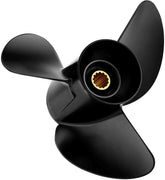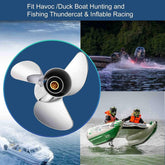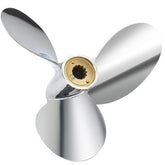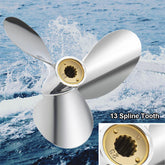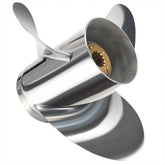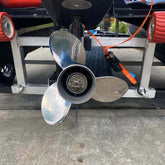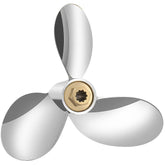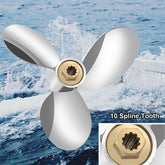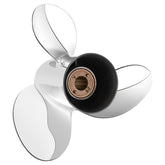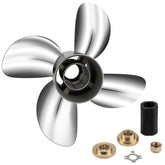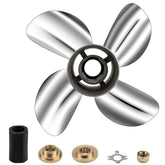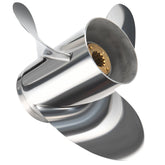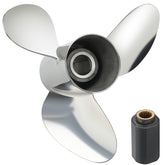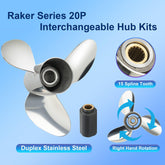Propeller Rings, Guards and Baskets — What They Do on a Boat
Why propeller protection matters for every boater
A spinning propeller is the most efficient way to move a boat — and also one of the most dangerous and vulnerable components on a vessel. Propeller rings, guards and baskets are simple mechanical additions that reduce risk to people, protect your prop from debris, and lower repair bills and downtime. For owners and operators running outboard propellers, inboards or PWCs, the right protection solution preserves performance while improving safety and uptime.
At VIF we design and manufacture OEM-grade propellers and accessories with factory-level quality and North American distribution. If you run rental fleets, tournament boats, tritoons, bass boats, or leisure pontoons, thinking through propeller protection up front will save money and add peace of mind on the water.
What are propeller rings, guards and baskets?
Propeller rings (anti-ventilation rings)
A propeller ring — sometimes called an anti-ventilation plate or anti-vent plate — is a structural feature fitted forward of the propeller or integrated into a guard that reduces the likelihood of air being drawn into the propeller (ventilation). Rings help maintain consistent water flow around the blades, improving bite and reducing cavitation in choppy or shallow conditions.
Propeller guards (blade guards / prop guards)
A propeller guard is a physical barrier that surrounds the propeller blade tips. Guards can be full shrouds, partial rings, blade tip protectors, or cages mounted to the lower unit or transom. Their main function is to deflect ropes, weeds, and small debris and to reduce the severity of blade strikes.
Propeller baskets (debris baskets / line catchers)
Baskets and line-catch devices are accessories placed near the prop that trap floating debris — lines, seaweed, plastic — before they can wrap around the prop shaft or jam the blades. They are particularly useful in shallow, weedy, or working environments where line and kelp are common hazards.
What do propeller rings, guards and baskets do on a boat?
1. Protect people in the water
The most important role is safety. A properly designed guard or ring reduces the exposed blade area and lowers the chance of severe injury to swimmers, divers, or people in the water near the stern. While nothing replaces good operating procedure and lookout, guards are a proven engineering control that adds a layer of protection.
2. Reduce propeller strike severity
A prop strike (hitting a log, rock or submerged object) can bend blades, score the hub, or damage the lower unit. Guards and rings absorb or deflect some impact energy, frequently preventing catastrophic damage to expensive gear. This reduces boat propeller repair frequency and cost.
3. Prevent entanglement from lines and weeds
Fishing line wrapped around the prop shaft is a common cause of abrasion to seals and a leading reason for prop removal/repair. Baskets and guards stop lines and weeds from reaching the blades or the hub, cutting down service intervals and improving reliability.
4. Improve ventilation control and thrust under some conditions
Anti-ventilation rings help stabilize the water flow to the blades, reducing ventilation and improving thrust in rough water or during heavy transom lift. For workboats, tritoons and heavily loaded pontoons, rings can improve low-speed thrust and control.
5. Extend prop and hub life
By preventing repeated dings and by reducing the severity of impacts and entanglement, guards and baskets extend the working life of both aluminum and stainless steel propellers. Fewer repairs mean lower lifetime cost and less downtime.
Which protection solution is right for your boat?
Choosing between rings, guards and baskets depends on boat type, engine type, operating area and performance priorities.
Small PWCs and mini jet ski use
Personal watercraft (jet skis) use impellers rather than exposed props, and prop guards aren’t applicable in the same way. For PWCs, focus on impeller maintenance, intake grate protection, and riding rules to reduce hazards.
Outboard-powered fishing boats and bass boats
For aluminum bass boats and performance rigs, exposed propellers are often needed for top speed and agility. In many cases owners prefer minimal guards to avoid drag. If you operate in heavy debris or rental use, a slimline guard or a line-catcher basket is a practical middle ground.
Pontoon and tritoon boats
Tritoons and heavy pontoons often benefit from more robust protection because they operate in shallow, nearshore waters and carry multiple passengers. A full shroud guard or a basket can protect passengers and lines while still allowing acceptable efficiency for cruising.
Workboats, skiffs and rental fleets
If your boat works around docks, swimmers, or frequent debris, prioritize protection. Rental and school operators should favor guards and baskets that are easy to inspect and replace. The slightly increased drag is a small cost compared with medical, legal, or repair liabilities.
Common concerns: will a prop guard hurt my performance?
Drag and top speed
Any device around the prop adds wetted surface area and can create a small amount of drag. For most recreational and work uses the performance impact is marginal — a few percent difference in top speed — and the operational upside outweighs the cost. For high-performance race applications or speed-focused tournament bass boats, many owners forego guards to preserve maximum top-end speed.
Cavitation and ventilation
Poorly designed guards can change the flow into the prop and increase the risk of ventilation if the ring or shroud unnaturally redirects water. Choose guards engineered for your lower unit size and propeller diameter; good designs minimize negative flow effects and even help stability.
Compatibility with stainless vs aluminum props
Guards work equally with stainless steel propellers and aluminum propellers. Because stainless blades are stiffer and thinner, they are less tolerant of minor contact, so a guard can protect a higher-value stainless prop better. Aluminum props are more forgiving when small impacts happen, but guards still reduce cumulative damage.
Installation and fitment: practical checklist
Match the guard to shaft and gearcase
-
Confirm spline count, shaft diameter and gearcase compatibility before buying a guard. Many guards mount to the skeg or use universal clamps, but correct fit prevents vibration and incorrect thrust angles.
Check rotation and blade clearance
-
Ensure the guard does not contact the blade at full throttle or under heavy load. Clearance should allow for blade flex—especially on stainless steel props.
Hub and shaft maintenance
-
Whenever you remove or inspect a prop, check the propeller hub insert (e.g., replaceable elastomer hubs) and the propeller shaft seals. Line wraps and small objects often damage seals and cause oil leaks.
Quick-access designs for fleets
-
For rental or instructional operations, use guards that allow quick inspection and fast removal without special tools.
How propeller rings, guards and baskets interact with other gear
Propeller shaft and drive shaft alignment
A misaligned drive shaft increases vibration, which magnifies any weakness in the guard mount. Proper shaft alignment reduces wear on mounts and keeps guards from loosening or creating noise.
Integration with propeller protectors and skeg guards
Skeg protectors and rock guards complement propeller guards by shielding the lower unit and skeg from abrasion. Combined, they lower the risk of costly gearbox or skeg damage.
Effect on cavitation control features
Modern propellers use cupping and blade geometry to reduce slip. A well-designed ring or shroud should preserve the designed flow over the blade and not defeat the manufacturer’s cavitation-control geometry.
When you should definitely add a prop guard or basket
-
You operate in weedy, debris-filled or shallow waters regularly.
-
The boat carries untrained passengers, rentals, or students.
-
You run close to swimmers, divers or tow passengers for watersports often.
-
You need to minimize downtime and maintenance costs (commercial use, guides, charters).
-
You’re protecting high-value stainless-steel propellers or precision hub systems.
Inspection and maintenance: keep protection working
-
Inspect guards and baskets visually after every outing for cracks, loose fasteners, or deformation.
-
Remove debris regularly and check that the guard isn’t trapping small items against the blade.
-
Balance check: If the boat starts to vibrate more than usual, inspect both the prop and guard for damage and rebalance the assembly if needed.
-
Replace worn clamps, bolts, or sacrificial elements immediately to avoid failure under load.
How VIF approaches prop protection products (short brand note)
VIF supplies OEM-grade propellers and can provide matched accessories for common Mercury, Yamaha, Suzuki and Volvo engine families. Our manufacturing control ensures hub fit, rotation options, and compatibility with standard lower-unit skegs and shafts. We offer timely North American shipping and reliable after-sales support for fleet customers and dealers.
(When you’re ready, we can insert specific model compatibility from your spec table — e.g., which prop guards pair with VIF prop models for 25 HP, 50 HP, 115 HP and up.)
FAQ
What are propeller rings, guards and baskets designed to do on a boat?
They are designed to protect people, prevent entanglement from lines and weeds, reduce the severity of prop strikes, and in some designs stabilize water flow to reduce ventilation. Guards and baskets also reduce repair frequency and keep boats on the water.
Will a prop guard significantly reduce my boat’s speed?
Most recreational and commercial installations see a small reduction in top speed (typically a few percent). For high-performance race boats aiming for every knot, owners often skip guards. For safety-conscious, family, rental or commercial operations, the trade-off is usually acceptable.
Can any outboard use a propeller guard or basket?
Not every guard fits every gearcase. Guards must match shaft diameter, spline count and skeg shape. Always confirm compatibility and clearance for your particular outboard model and propeller diameter.
Do guards affect fuel economy or slip?
A poorly matched guard could increase slip or slightly increase fuel burn. Well-designed guards for the correct engine and prop diameter minimize adverse effects and often pay back in reduced repair and downtime costs.
How do propeller rings help with ventilation?
Anti-ventilation rings guide flow and reduce air being drawn into the propeller disc, maintaining bite at low speeds or when the stern lifts. This can help loaded boats get on plane faster and reduce cavitation risks.
What’s the difference between a prop guard and a prop basket?
A guard physically shields the blade tips; a basket is designed to catch debris and prevent line/wrapping. Many fleet operators use both: a basket for debris prevention and a guard for blade protection.
How often should I check my propeller protector and basket?
Do a quick visual check every trip and a detailed inspection at the end of a day in heavy debris. Replace mounting hardware or sacrificial elements immediately when worn.


